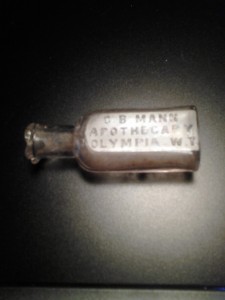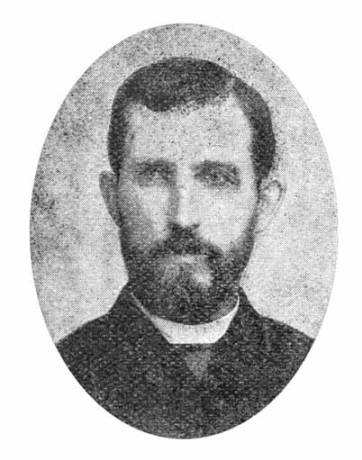Digging Up History: The Unintentional Washington State Library Connection
 From the desk of Steve Willis, Central Library Services Program Manager of the Washington State Library:
From the desk of Steve Willis, Central Library Services Program Manager of the Washington State Library:
A few decades ago, back when my family still had a farm out in northwestern Thurston County, my father noticed a small glass object that had surfaced after he plowed the field. The farm had once been home to an inn called “The Hicklin Halfway House” on the stage road between Olympia and Montesano in Territory days. We were used to plowing up small pieces of china and glass. But this was different.
Except for some chips on the opening, this small glass bottle is intact, about 3 inches high, and has the raised label: C.B. Mann, Apothecary, Olympia, W.T.
As it turns out, Champion Bramwell Mann ran a drugstore on the southeast corner of 4th and Washington in Olympia, site of the present Security Building. He was a prominent figure in the local history of the city, even serving as Mayor from 1894-1895. And, believe it or not, he had a short stint as the Territorial Librarian in 1870.
And so did his father, Sylvester Hill Mann. You can read about them and the other colorful characters who kept the flame alive in Washington’s oldest public institution on WSL’s biographical page: The Territorial Librarians.
Mann also appears in digital form on our Thurston County Pioneers Before 1870 section.
This was literally digging up some history with a Washington State Library connection. Even so, I don’t even want to try and imagine what sort of concoction this bottle once contained.
You can follow any responses to this entry through the RSS 2.0 feed. Both comments and pings are currently closed.







April 4th, 2012 at 12:14 pm
Regular imbibing of the bottle’s contents today could end up sending a person to a different sort of halfway house. To quote Historylink’s article on pharmacies in Washington:
‘…Crude opium was a popular pain reliever sold in nineteenth-century pharmacies, and many pharmacists kept 15-pound blocks of opium on hand. If a customer came in complaining of pain, the pharmacist could just cut a chunk off the block and hand it to the customer, who would soon be feeling much better.
‘Patent medicines were available in drugstores by the late nineteenth century, and were widely used. They continued to increase in popularity into the first years of the twentieth century, until a tightening of drug laws in the United States put the end to their heyday. Patent medicines frequently contained liquor, morphine, or opium, but these ingredients weren’t required to be revealed to the consumer. Nor did these medicines require a doctor’s prescription; a pharmacist could — and regularly did — make recommendations for a specific medicine to his customers. Lydia Pinkham’s Vegetable Compound was arguably one of the most successful patent medicines of the day, and was particularly favored by women looking to soothe “female problems.” (The 20 percent alcohol content in the medicine likely played a large soothing role.)’
http://www.historylink.org/index.cfm?DisplayPage=output.cfm&file_id=9988
April 5th, 2012 at 6:28 am
CB Mann was the initiator of the Thurston County Pioneers project, sending forms out to all of the pioneers he was aware of, or their descendants. In some cases, he filled out the answers himself.
April 5th, 2012 at 8:40 am
Thanks Deb. It seems Mr. Mann had the librarian/historian gene! Just the sort of person we needed to have serving as a Territorial Librarian.